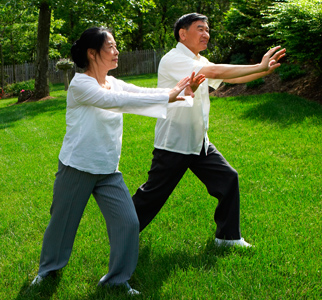Exercise Your Way to a Healthy Heart
Physical inactivity, high blood pressure, and smoking are risk factors for heart disease.
These risk factors can be reduced by living a healthy lifestyle, including exercise.

Eight ways to help your heart
Look at all the ways exercise can help your heart:
-
Reduces your risk of getting heart disease and can help prevent existing heart disease
from getting worse. It works by lowering stress hormones that cause inflammation.
Inflammation can damage the arteries that supply oxygen and nutrients to the heart
muscle.
-
Lowers your risk of getting high blood pressure
-
Lowers blood pressure in some people who have high blood pressure
-
Raises your high-density lipoprotein (HDL), or "good," cholesterol
-
Lowers your low-density lipoprotein (LDL), or "bad," cholesterol
-
Lowers the amount of triglycerides, a form of fat, in your bloodstream
-
Helps you lose extra weight, which can strain your heart
-
Makes your heart and lungs work more efficiently
Over time, fat and cholesterol can build up in your blood vessels. When arteries that
supply the heart and brain with blood become clogged, a heart attack or stroke can
occur. Exercise can help keep the blood vessels open. This can help prevent heart
disease or stroke.
Added benefits
Exercise may also protect against stroke. Walking, stair climbing, dancing, jogging,
and other activities of at least moderate intensity also reduce stroke risk. Plus,
exercise can help you prevent or manage several chronic diseases that become more
common with age: type 2 diabetes, osteoporosis, and arthritis.
Both your body and mind can benefit from exercise. Exercise can help you manage stress.
Stress can affect the heart directly and can impact other risk factors and behaviors
that affect the heart. These may include blood pressure, cholesterol levels, smoking,
and overeating. Cutting down on stress, however, can at least make your life more
enjoyable. Exercise can also boost your self-image and help counter anxiety and depression.
Which activities are right for you?
You don't have to strain your body to benefit from exercise. Even moderate exercise
is good for you. The CDC and the American Heart Association recommend at least 150
minutes of moderate-intensity physical activity or 75 minutes of vigorous-intensity
physical activity each week for substantial health benefits. They also recommend muscle-strengthening
activity at least 2 days a week. Examples of moderate activities include:
-
Walking
-
Gardening
-
Doing housework
-
Ballroom dancing
For more benefit to your heart and lungs, try more vigorous aerobic activity. These
are examples of more vigorous activities:
-
Jogging or running
-
Swimming laps
-
Bicycling briskly
-
Aerobic dancing
-
Cross-country skiing
-
Rowing
How to get physical
Use these tips to move toward a more active life:
-
Choose activities you like. The key to starting and sticking with an exercise program is to pick activities that
you enjoy. Then choose a convenient time and place to work out. Try to make exercise
a habit. Do different activities rather than relying on just one so that you don't
become bored with your routine. Finding an exercise partner may make it easier to
stick to a regular schedule. If you miss an exercise session, don't worry. Just find
another way to be active that day.
-
Build up your endurance. Start out by exercising slowly, especially if you haven't been active for a while.
This will allow your muscles to warm up. Gradually build up how hard, how long, and
how often you exercise. Be careful though. Overdoing exercise increases the risk for
injury. Listen to your body, and don't ignore any pain in your joints, ankles, feet,
or legs. If you stretch before exercising, do so gently. Also, take plenty of time
to stretch at the end of each session. This can help you become more flexible.
-
Drink plenty of water. While you exercise, drink some water every 10 to 20 minutes, especially in hot, humid
conditions. Be sure to drink before you feel thirsty. You can't always rely on thirst
alone to tell you when you need more fluids. Also, be sure to drink water before and
after you exercise.
-
Check with your healthcare provider before starting any new exercise program. This is especially important if you have been inactive for a while. It is also important
if you have a chronic health problem like heart disease, diabetes, or obesity, or
if you are at high risk of developing these problems. If you have any chest pain or
discomfort during exercise that goes away after you rest, call your healthcare provider
right away. If your exercise-induced chest pain does not go away with rest, call 911.
This can be a sign of heart disease and a heart attack.
Exercise tips
Make exercise a part of your life with these tips:
-
Walk, jog, or bike around town instead of driving.
-
Take an activity break during the day instead of eating a snack.
-
Find out if your local shopping mall opens early for indoor walkers.
-
Listen to music or watch TV to keep yourself entertained while you exercise.
-
Surround yourself with people who support and encourage you.
-
Set realistic exercise goals. Reward yourself when you achieve your goals.
-
Plan vacations around activities like hiking or swimming.
-
Park your car in the back of the parking lot to have a longer walk into the store
when you go shopping.